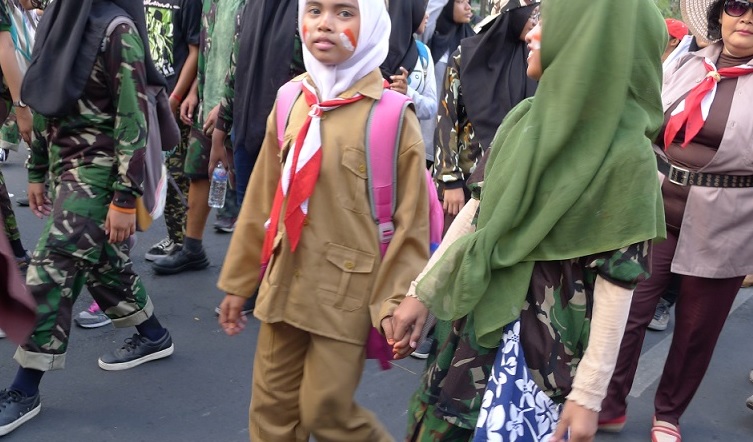藝評
印尼泗水兩個完美的晚上 | Two perfect nights in Surabaya, Indonesia
約翰百德 (John BATTEN)
at 3:12pm on 24th October 2018

圖片說明 Captions:
2015年11月10日,印尼泗水的英雄日巡遊。Hari Pahlawan (Heroes’ Day) parade, Surabaya, Indonesia, 10 Nov 2015.
攝影Photos:約翰百德John Batten
(Please scroll down for English version)
早前發生的地震、海嘯、印尼盾匯價跌至二十年新低,還有我坐在巴士上層,途經香港仔隧道時遇上,那位向外凝望、戴著頭巾的女士,都讓我想起數年前的一次旅程,我到了一個為自己自豪的城市。
很久以前,我讀過的資料曾經提到,印尼東爪哇首府泗水擠逼而且污染嚴重,是不宜久留的地方。然而,我到達當地時卻未能證實以上所述是否屬實,因為我馬上由泗水機場轉往巴士站。
我本來打算由泗水乘火車前往日惹,但火車班次和我由香港飛抵印尼的航班沒法配合,最後只能選乘通宵巴士提早到達日惹雙年展,我在印尼短遊一週的重點行程。公路上,我沉靜地看見路邊有很多警察檢查站,也有以骷髏頭和交叉骨頭組成的警告標誌,以及被棄置一旁的車輛殘骸。然後,最令人警覺的,是以撞車廢鐵堆疊而成的高柱。這並不是什麼前衛風格的雕塑,而是這條連接兩個城市單線車行道上的終極警告。儘管巴士司機顯然認識這條路,但他純熟的超車卻是貼近死亡多於抗拒死亡……
回程的火車車程令人心情輕鬆,途中看到稻田收割後縷縷輕煙的景色。城市的工商用 地佔據了外圍市郊的邊緣,然後我們來到了泗水的古朋火車站。我登記入住酒店後,馬上前往市內有名的阿拉伯區,這裡以蘇南.安佩爾清真寺和墓地為中心。蘇南.安佩爾是十五世紀時在爪哇傳揚伊斯蘭教的九名聖人之一。清真寺旁的有蓋市集出售手制布料、香水、棗(蜜蜂在其上飛來飛去),還有各式各樣宗教物品。餐館和咖啡座服務住在鄰近朝聖旅舍的旅客。數十年前,那裡主要招待等待船隻前往麥加朝聖的哈吉回教教徒,又或被運往遙遠荷蘭殖民地的爪哇勞工。這段歷史正好說明為什麼時至今日,南非開普仍有零散地聚居數百年的爪哇人。
我在沒有汽車行走、令人感覺舒服的後街中流連。偶爾打破小街寧靜的,就只有路經的電單車、正在嬉戲的小童,又或手中拿著搖鈴上門叫賣的小販。漂亮的戰前排屋,是混合了荷蘭殖民與爪哇特色的建築,綴以印尼的鮮艷色彩:綠、藍、粉紅。精緻的手製回紋裝飾三角木楣讓空氣在坡面瓦頂屋內流通。鳥兒在掛於室外的籠中歌唱,成為了這段漫步的背景音樂。
拐了一個彎後,我來到一條曾經在舊日買辦時代服務海港和貨倉的舊運河附近,這裡正舉行英雄日巡遊。印尼在二戰後首場對抗荷蘭殖民主義者回歸的重大革命戰,於1945年11月10日在泗水爆發。巡遊結合了喜氣洋洋的服裝,是一場國民引以為傲的慶典,有小女孩穿著直排滾軸溜冰鞋列隊、有身穿卡奇色服裝的老兵坐在裝有機關槍的吉普車上、有精神飽滿的救火雜技、有銅管樂團、有傳統竹製樂器鼓樂,還有一隊裝上拉長前叉車輪的逍遙騎士/戰甲飛車式單車。和其他觀眾一樣,我在街頭小檔吃點小吃,然後走進了運河旁的公園。
泗水殖民地藝術裝飾建築與荷蘭現代主義的遺跡散落市內。Sarkie兄弟是亞洲顯赫有 名的酒店經營者,它們在Jalan Tunjungan興建了現已更名為滿者伯夷的酒店,足證該市在貿易上的重要地位。滿者伯夷酒店是品牌遍佈亞洲的豪華酒店之一,姊妹酒店還包括譽滿檳城的Eastern & Oriental、新加坡的萊佛士酒店,還有仰光的The Strand。經復修後,滿者伯夷酒店仍然散發舊時代的輝煌。
泗水也開設了新式大型商場,也有擠迫的車道和疏離的天橋,但我全都錯過了。有時候,在一個城市短留兩天,可以得到最佳的體驗。
泗水與蘇拉威西的地震相距甚遠,但這次泗水的英雄日巡遊,卻毫無疑問地表達出強大的團結精神,以及為未來復興。正如當荷蘭人曾誤以為在二戰後,生活會從返殖民時代,但印尼國民卻奮力對抗一樣。
原文刊於《明報周刊》,2018年10月11日
Two perfect nights in Surabaya, Indonesia
by John BATTEN
The recent earthquakes, the tsunami, the drop of in the rupiah to its lowest level in twenty years, and then seeing a young head-covered woman sitting in the front top-deck of the bus quietly gazing out the window as it travelled through Aberdeen Tunnel, reminded me of a trip a few years ago to a proud city.
Long ago, I had read that Surabaya, East Java’s provincial capital, was crowded, polluted and not much of a place to linger. However, after my arrival none of that was tested as I immediately went from Surabaya’s airport to the bus station.
I had wanted to take a train from Surabaya to Yogyakarta, but the trains and my flight’s arrival from Hong Kong did not coincide. I opted for an overnight bus and an earlier arrival for the Yogyakarta Biennial, the focus of my week in Indonesia. Once on the road, I sagely saw the many roadside police checkpoints, skull-and-cross-bone warning signs and abandoned car wrecks on the roadside. Then, as the ultimate caution, were pieces of crashed car debris mounted on a tall plinth. This was no avant-garde sculpture, but a dire warning of the single carriageway running between the two cities. The bus driver obviously knew the road, but even his skilled overtaking was closer to death than death-defying…
The relaxing return train trip went through a post-rice harvest landscape of burning smoke. The city’s industry and commercial plots fringed the outer suburbs and then we arrived at Surabaya’s Stasiun Gubeng. I checked into a hotel and immediately headed to the city’s famed Arab district centred around the mosque and tomb of Sunan Ampel, one of the nine saints who propagated Islam on Java in the 15th century. The covered bazaar near the mosque sold handmade cloth, perfumes, dates (attended by hovering bees), and religious paraphernalia. Restaurants and cafés served visitors housed in nearby pilgrim hostels. Decades ago they would have predominantly accommodated hajjis waiting for boats bound for Mecca or transported Javanese labour to further-afield Dutch colonies; which explains the presence, even now, of centuries-old pockets of Javanese living in South Africa’s Cape Town.
I wandered the pleasantly car-free back streets, disturbed only by an occasional motor-bike, playing children and bell-in-hand hawkers selling door-to-door. The beautiful pre-war row houses were a colonial Dutch/Javanese hybrid with touches of Indo brightness: green, blue, pinks. Hand-fretted wooden pediments were delicate decoration and allowed air to circulate in the steep tile-roofed houses. Birds singing from outdoor hanging birdcages were the musical accompaniment.
Then I turned a corner, near one of the old canals that served the port and godowns from an earlier comprador era and met a Hari Pahlawan (Heroes’ Day) parade. The first major revolutionary battle against the return of the Dutch colonialists in Indonesia after World War II was in Surabaya on 10 November 1945. The parade was a mix of happy fashion and proud celebration with small girls in formation zipping along on rollerblades, khaki-clad veterans sitting in machine-gun mounted jeeps, a lusty display of fire-fighting gymnastics, brass bands, traditional drumming on bamboo instruments, and a brigade of Easy-Rider/Mad Max bicycles with elongated front-forked wheels. Like everyone else, I snacked from the street food stalls. Then walked in the canal-side parks.
Remnants of Surabaya’s colonial art-deco architecture and Dutch modernism is scattered around the city. Confirming the city’s trading importance, Asia’s pre-eminent hoteliers, the Sarkie Brothers, built the (later re-named) Majapahit Hotel on Jalan Tunjungan, to join a luxury hotel portfolio that included the famed Eastern & Oriental in Penang, Raffles in Singapore and The Strand in Rangoon. It still stands in renovated glory.
Surabaya does have new shopping malls, crowded motorways and alienating overpasses, but I had missed them all. Sometimes, a two-night stay in a city gives the best experience.
Surabaya was far from Sulawesi’s earthquake, but this year’s Heroes’ Day parade in Surabaya will, no doubt, express a spirit of strong solidarity and future renewal. Just as the country did to vanquish the return of the Dutch, who had mistakenly thought that after the end of the Second World War life would again return to its colonial past.
Published in Ming Pao Weekly, 11 October 2018, Chinese translated by Aulina Chan.
|
|
|
|
|
|
